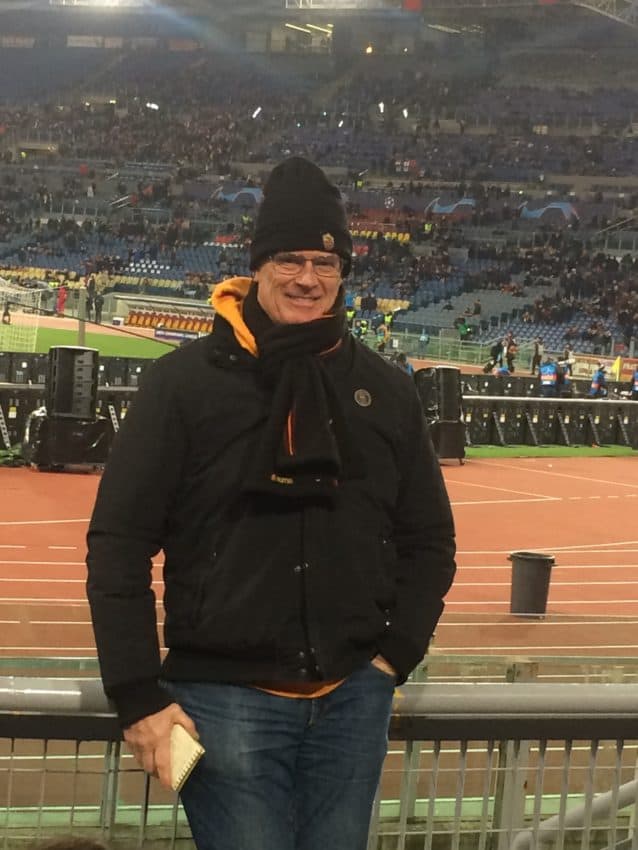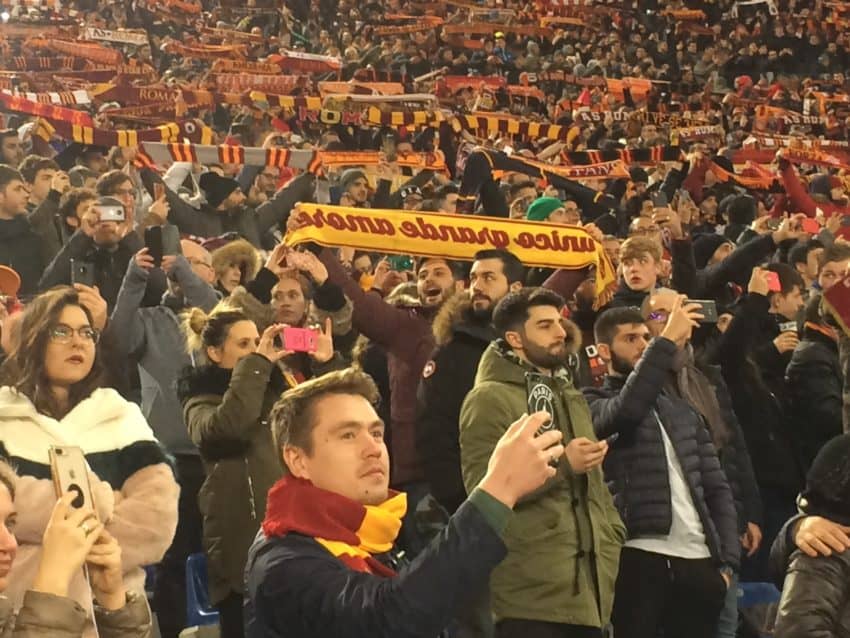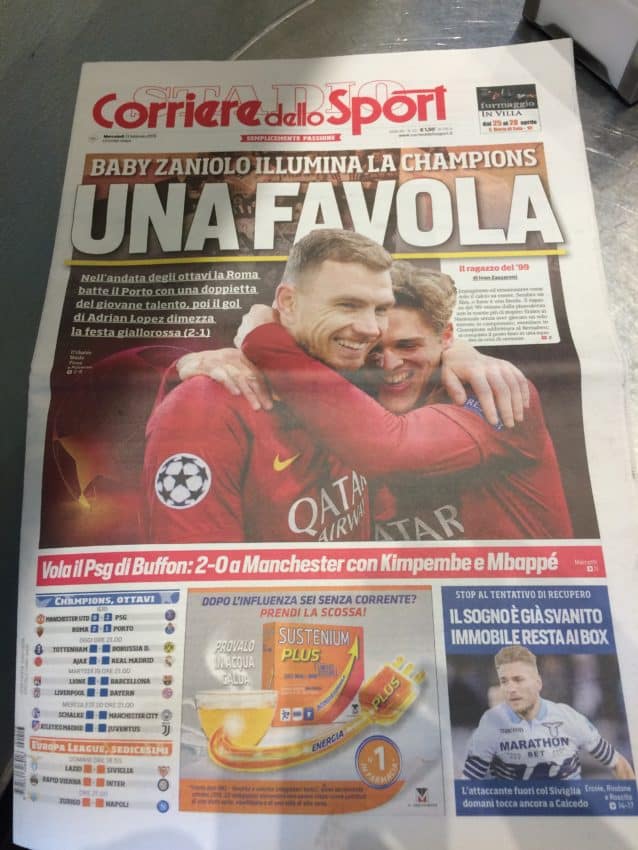A trip to Rome’s Olympic Stadium is worth the hassle when Roma wins

Did you know a comb could be a weapon?
And it’s not even a big comb, one of those knife-length jobs you slip in your back pocket, the kind James Bond may have used to cut a Russian spy’s throat. It’s a little round collapsible comb that pops out when you lift the lid and push up from underneath. For years I carried it in my left front pocket, not knowing I had a concealed weapon in my possession.
In Rome’s Olympic Stadium, it is.
Security guards confiscated it Tuesday night when I went through the gate. I asked the female guard what possible harm could I do with this, thinking maybe her tip would be handy if I ever meet a Trump supporter. She made a throwing motion as if hurling a fastball, showing pretty good velocity.
So they don’t want me throwing it on the field or at opposing fans. They were searching everybody everywhere. Pockets. Purses. Backpacks. Limbs. I thought I saw a proctologist on call nearby.
Welcome to the soccer game experience, Italian style.
I’ve seen nearly every AS Roma game this season but this was my first trip to see one live. I eschewed my normal mid-field press tribune seat for a 50-euro ticket with my fellow American expat/Romanista, Loren, an English teacher from Long Island who left Rome last June for Zurich. Two things she misses about Rome are the food and football.
We tried to get a group together but it wasn’t easy. Some begged out because it was a work night and a 9 p.m. start; others didn’t want to hassle with going to the stadium.
And it is a hassle. Even getting there is a problem. Rome is the only capital I know in Europe that does not have a train going to its stadium. One must rely on Europe’s worst public transportation system, Atac, only slightly more reliable than hitchhiking and not much safer. Unlike Rome’s buses, at least cars driven by psycho loners with butcher knives don’t inexplicably burst into flames. If you drive, you must park at least a kilometer away per the absurd security precautions. You never know when a suicide bomber frustrated with Roma’s coaching staff runs his explosives-laden Fiat into a panino stand.
Once at the stadium, the security is something akin to that at a North Korean nuclear facility. You show your ticket plus a photo ID to get through the first gate. The ticket MUST have your name on it to foil scalpers. I’ve seen some in Italy hover outside gates selling discount tickets to unwitting, casual tourists who are then denied entry but learn their first Italian word: ladro (thief).
Then you walk 50 meters and go through an electronic turnstile where you press the ticket’s barcode against a machine’s blinding light, unlocking the gate you walk through. Greeting you is a squadron of security guards who pat you down, feel your pockets and view grooming products as hand grenades.
At the same time you’re arguing the relative merits of combs, a monitor is photographing your face to match up in case a camera inside the stadium catches you hurling a javelin at the opposing goalie.
Still, coming to an AS Roma game as a fan is an experience I can’t get at my midfield seat with the video monitor in front of me and access to press room pizza. It’s definitely more exhilarating than sitting in the cramped upper room of my soccer pub with the other Romanisti eating fish ‘n chips and breaking down Brexit.

And Tuesday night was special: AS Roma-Porto, the Champions League knockout stage. It’s the perfect time to write an update on my favorite sports team. It’s the one liferaft of fandom I’ve grasped after 40 years as a crusty (“WHERE ARE THE STATS???!!!”), emotionally bankrupt (“When’s last call?”), cynical (see above graphs) sportswriter.
It has taken a while this season to hop aboard. The offseason was painful. Ramon Rodriguez Verdejo, the Spanish sporting director known as “Monchi” brought over from Sevilla two years ago after directing it to 11 trophies, headed a purge of Roma’s guts. Gone went Alisson Becker, 25, in the discussion as the world’s best goalkeeper, to Liverpool. Midfielder Radja Nainggolan, 30, the heavily tattooed fan favorite and on-field enforcer, rejoined former Roma coach Luciano Spalletti at Inter Milan. Midfielder Kevin Strootman, 28, a major locker room leader, rejoined Rudy Garcia, another ex-Roma coach, in Marseille. In Alisson (a goalkeeper-record 62.5 million euros), Nainggolan (38 million) and Strootman (25 million) the club got 130.5 million euros in transfer fees.
With that they went out and bought a bunch of kids. Arriving from Dutch power Ajax came Justin Kluivert, 19, son of the former Dutch international Patrick Kluivert, for 17.25 million. Patrik Schick, a 22-year-old striker from Czech Republic, came from Sampdoria for 9 million and attacking midfielder Nicolo Zaniolo, 18, came aboard from Inter for only 4.5 million. The biggest acquisitions were Sevilla midfielder Steven Nzonzi, 29, fresh off helping France to the World Cup title, for 26.56 million; Paris-Saint Germain midfielder Javier Pastore, 29, for 24.7 million; and goalkeeper Robin Olsen, 28, from FC Copenhagen and who blanked Italy twice to send Sweden to the World Cup, for 8.5 million.
Financially they came out ahead but how much farther ahead on the field would they get banking on the future? And who is this Zaniolo kid? If he looked any younger his mom would hand him Orange Slices after games.
Juventus, the 500-pound carnivore and seven-time Serie A defending champion, added world icon Cristiano Ronaldo and was basically handed the trophy before the first whistle blew in August.
Roma started with 1 win, 2 ties and 2 losses and later lost to 14th-place SPAL at home, 2-0. Olsen was a serviceable replacement for Becker but the defense was terrible and Dzeko, who led Roma last year with 24 goals, was hurt and ineffective. The young kids were still getting comfortable. With veteran captain Daniele De Rossi out with a knee injury, the leadership was nil. In mid-December, Roma stood at 5-6-4 and Roma’s famously impatient and vicious fans had had enough.
On Dec. 16, before a home game against Genoa, the Roma Ultras organized a protest. Thousands didn’t enter until 11 minutes had passed in the game. Those already in the stands turned their backs on the field during player introductions and whistled loudly at the announcement of every player’s name but De Rossi and Zaniolo.
Roma won three of its next four, losing only at Juventus 1-0, to enter the winter break 8-6-5 but it hit rock bottom when it returned. On Jan. 27, it blew a 3-0 lead at Atalanta and tied 3-3 then three days later at Fiorentina got filleted in 7-1 in the Italian Cup, the national tournament not held in high regard except when it’s an excuse to fire the coach.
Eusebio Di Francesco, who arrived last season from Sassuolo and led Roma to the Champions League semifinals and third place in Serie A, couldn’t have been on a hotter seat if the broiler was set on nuclear. James Pallotta, the embattled American owner, said he’d leave the decision to Monchi who steadfastly supported Di Francesco.
Di Francesco, a midfielder on Roma’s last Serie A championship team in 2000-01, has spent all season one step ahead of the executioner’s axe. Roma looked solid in a 1-1 tie against Milan then Dzeko, who awoke from his Serie A coma to score two goals at Atalanta, scored another in a 3-0 win at Chievo. The fact that Chievo is in last place was lost on the 51,000 fans who nearly sold out Olympic Stadium Tuesday hoping Roma could continue its Champions League magic.
Roma finished second behind Real Madrid in the Champions League group stage in which Dzeko had five goals in six games, giving him 15 in the competition for Roma all time, only two behind leader Francesco Totti, Roma’s living god. Roma is rising in Serie A as well, standing 10-8-5 in a three-way tie for fifth place, one point behind Milan for the fourth and final Champions League spot for next season.
Loren and I, being Americans, had to start our evening with a beer. Drinking in Olympic Stadium is an odd experience for an American. There’s never a line, especially weird since the 4-euro price is about half the price of beer in your average American stadium. Romans drink beer like Brits drink tea: slowly and sparingly. I’ve seen so few fans drink beer in the stadium I thought it wasn’t even sold, not because they want to curb rowdiness but because it flat out wouldn’t sell. Olympic Stadium is as sober as St. Peter’s.
We took our seat in the fourth row on one corner of the north end. It’s about as close to the field as you’ll get but with the eight-lane track still left from the 1960 Olympics, the distance from the end lines doesn’t make up for the low vantage point. However, we did get good views of the 3,500 Porto fans who came from Portugal to jam pack one section of the north end, cordoned off from the Roma fans by a tall Plexiglas fence, an empty section and an army of security guards, lined up like sentries on every step.
At 8:10 p.m., a good 50 minutes before the game, the Porto fans lit a fuse under a Rome fan base that only needs a cold shoulder to eat Plexiglas. They started hurling objects that looked like food and fluids over the Plexiglas into the Roma section. Roma fans responded with outstretched arms, the Roman hand gesture for “I mortacci tua” (May your entire family die.) Porto fans then waved the red cape by holding up a “FORZA LAZIO” banner and a jersey of Paolo Di Canio, the former Lazio player known for his fascism.

Not to be outdone, some Ultras in Curva Sud held up a banner reading “BASTARDO KOLAROV,” a biting cut to Aleksandar Kolarov, the veteran Serbian defender who has become the fans’ paddling boy for Roma’s defensive deficiencies. The banner was quickly removed.
Olsen was still nursing a calf injury and Roma started at goalkeeper Antonio Mirante, a 35-year-old journeyman making the biggest start of his career but I’d seen him make the second best save all season at Chievo and wasn’t worried.
However, Porto is no Chievo. It is the New York Yankees of Portuguese soccer — except Porto is still winning. It has won 28 Primeira Liga titles, second only to Benfica’s 36, but 10 of the last 16, including last year’s. It was in first place when it took the field on a clear 40-degree night Tuesday with clear memories of eliminating Roma two years ago.
The first half wouldn’t win over my old farm boy sports editor who called soccer “kickball.” Through 23 minutes, no team had a shot on goal. I looked at this glass as half filled and chalked up the 0-0 halftime score to a great defensive game, one I’d settle for after watching the bludgeoning at Fiorentina from an angry pub.
But Roma started pressing the action in the second half with Stephen El-Shaarawy skying an open shot in the 55th minute and Rome native Alessandro Florenzi hitting a bullet saved by craggie goalkeeper Iker Castillas, who led Spain to the 2010 World Cup title.
Finally, in the 70th minute, Dzeko outraced all of Portugal down the field and fed a perfect ball to a charging Zaniolo who slotted in the corner of the net for a 1-0 lead. Six minutes later, Zaniolo did it again, taking a Dzeko shot that ricocheted off the pole into the corner to make it 2-0.

Yes, Roma finally has a young star and Zaniolo is finally a bigger star than his mom whose selfies have gone viral. Yes, Francesca Costa’s shots of herself on the beach in bikinis and posing in miniskirts in front of the mirror is the mother of Roma’s baby-faced sniper. From whence came this 19-year-old who has five goals in 22 games and made his Roma debut at — gulp! — Real Madrid in the Champions League Sept. 19.
Born in the Tuscany beach town of Massa, the son of a former Serie B and C player came up through Fiorentina’s youth system but was released in 2016. He hooked on with Serie B Virtus Entella two years ago and in July 2017 signed with Inter where he became its developmental team’s top scorer with 13 goals. Last summer, Inter shipped him and Davide Santon to Roma for Nainggolan, one of Monchi’s many moves that made many of the more polite fans go, “Che CAZZO! (What the fuck?)”
Zaniolo was hailed long after a Porto goal in the 76th minute made it a 2-1 final. The goal made Roma’s return leg in Portugal March 6 a little more frightening (teams advance on accumulative score with away goals serving as the first tie-breaker) but considering our season, the 2-1 victory seemed like a stay of execution.
The crowd was remarkably subdued at the final whistle. The rollicking “Grazie Roma” sung by fans arm in arm didn’t have the usual verve. In an up and down year, polite team songs sometimes take a back seat to more symbolic post-game looks like the one right near me.
A young man in a gray hoodie facing the Porto section with two middle fingers waving in the air.


February 16, 2019 @ 2:12 am
So combs are a no but flares yes! Odd isn’t it?
I love going to the stadium in Italy; I’ve never been to the Olimpico, but I’d love to go see the derby once, perhaps in the Roma’s Sud. I agree about the teetotalling experience, even though I do remember seeing Samp playing Genoa at Marassi through a literal wall of fog of Super Silver Haze… Here’s to hoping somebody breaks the Gobbi running streak, I’m bored to see Juve win!
February 17, 2019 @ 7:35 am
Sounds like a great match to go to. Nothing beats a live football game even if the atmosphere was a little toxic. Its a shame the Italian League has become so one-sided with Juve dominance as it used to be so open. Can’t see them being caught for a few years unfortunately. Great post though, and great football write-up.
February 17, 2019 @ 10:46 pm
Felt like I was there and wish I was. Surprised to see 51,000 people were there. Seem to remember a boycott because of a barrier in the stands that city officials wouldn’t remove. Something like that? Anyway, glad you had a great time. Such a different perspective from fan seats.
February 19, 2019 @ 3:25 am
Thanks for the blog and introducing me to the ‘proctologist’. – had to look it up.
Don’t the rugby Azzuros play there (olimpico) as well?